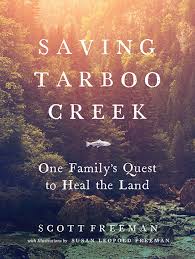 When Scott and Susan Freeman purchased an eighteen-acre parcel of land in Washington’s Olympic Peninsula in 2004, they could see that decades of logging and unsuccessful farming had taken their toll. The landscape was riddled with noxious, invasive plants––thorny stands of Himalayan and Eurasian blackberry, mats of reed canary grass, and tall swaths of horsetail and thistle. Tarboo Creek, the once-robust salmon stream that flowed through the property, “looked like an open wound.”
When Scott and Susan Freeman purchased an eighteen-acre parcel of land in Washington’s Olympic Peninsula in 2004, they could see that decades of logging and unsuccessful farming had taken their toll. The landscape was riddled with noxious, invasive plants––thorny stands of Himalayan and Eurasian blackberry, mats of reed canary grass, and tall swaths of horsetail and thistle. Tarboo Creek, the once-robust salmon stream that flowed through the property, “looked like an open wound.”
In Saving Tarboo Creek: One Family’s Quest to Heal the Land (Timber Press), Freeman describes how he and his family, as part of an intensive, community-wide effort, restore the waterway and surrounding lands. A local excavator sculpts a shallow, meandering stream, then drops old trees in strategic locations to create pools for the fish. Several inches of gravel are sprinkled onto the bottom of the stream bed. Banks are seeded and covered in hay. Finally, water is diverted to its new home. Over the next decade, more than 10,000 native shrubs and trees are planted in the surrounding floodplain and abandoned pasture.
Freeman teaches biology at the University of Washington. His wife, Susan, provides the book’s delightful, pen-and-ink illustrations and is the granddaughter of Aldo Leopold, one of the twentieth century’s most important conservation thinkers and author of A Sand County Almanac (1949), the groundbreaking book that advocated for moral responsibility toward the land. The Freemans are, in short, part of a multi-generational family steeped in ecological awareness and land-restoration expertise.
Freeman is a close observer of the natural world, and his descriptions are lyrical and compelling. When salmon return to Tarboo Creek for spawning, they “arrive a fire-engine red and bristling with vigor but are dead in less than two weeks. The females beat the skin and muscle right off of their tails as they dig a nest for their eggs.”
And who knew about nurse logs—fallen tree trunks whose rich, rotting structure serves as an ideal growing site for a new generation of trees? “Once an old tree has been down for a decade or two,” he writes, “it’s common to see a row of four-foot-tall hemlock or cedar saplings lined up along its back, like schoolchildren waiting for the bell.” Freeman also depicts a family that’s deeply connected to the rhythms of the land. On spring nights, Scott and Susan can gauge the warmth of their pond simply by listening to the tree frogs. And it’s not unusual, on an autumn afternoon, for several children to sit shoulder-to-shoulder along the stream bank, watching a female salmon dig her nest and naming the males that hover nearby.
But Saving Tarboo Creek is not simply a happy tale of ecological restoration. Freeman’s superb chapter on salmon includes a grim history of the animal’s near-extirpation. A lovely description of tree-planting morphs into a stark chronicling of global deforestation––followed by sober discussions of climate change, human overpopulation, and an impending mass extinction. “Biological and cultural evolution has now put human beings in a position of immense power relative to other species, and we can be destroyers or stewards,” he writes.
Freeman dedicates this book to the young men and women––his father-in-law, Carl Leopold, among them––who saved the world from tyranny during World War II, and also to the high school and college students of today: it’s your turn, he says, to step up and save the world.
But just how does he propose doing this? Rather than providing thoughtful, practical suggestions, Freeman preaches against what he sees as a “poverty of values” in our society––a focus on consumerism that leaves us unhappy, unhealthy, and out of touch with the natural world. And in trying to illustrate just how out of whack we’ve become––fretting about how many Americans take medication for depression, or alter their appearance through plastic surgery––he goes too far. Freeman risks not only sounding sanctimonious, but alienating those whom he will need to enlist if he hopes to turn the tide on environmental issues. (The fight to save the world needs everyone––even those who’ve had a little nip and tuck.)
I finished this book wanting more information. What does Freeman recommend to readers who are anxious to join the battle, but have no idea where to start? And for those living in high-rise apartment buildings––more likely to line a windowsill with potted ferns than purchase a piece of land––what useful steps does he suggest?
Saving Tarboo Creek shows us a remarkable slice of the natural world. I only wish it offered more advice on saving it.
___
Tucker Coombe writes about nature and education from Cincinnati, Ohio. Her work has appeared in the Los Angeles Review of Books, The Rumpus, and The Hairpin, and can be found at tuckercoombe.com.
